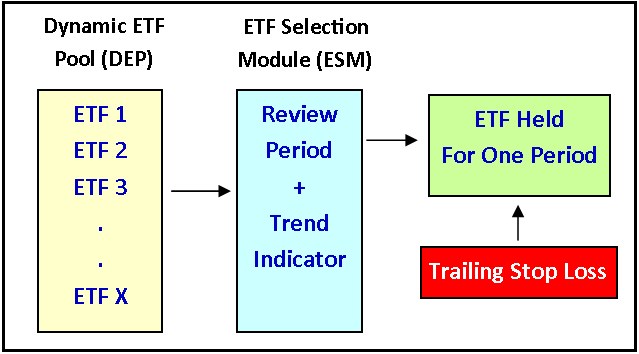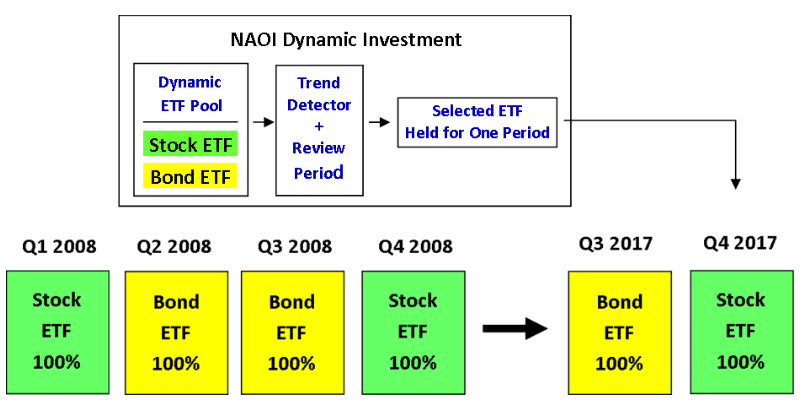The Investment Type of the Future
As you have read on the page at this link, Dynamic Investment Theory sets the logic and rule-set for the creation of an innovative investment type called NAOI Dynamic Investments (DIs). They are capable of automatically changing the equities (either ETFs or Mutual Funds) they hold based on a periodic sampling of market trends. On this page I show how DIs work, the level of performance they can produce and how.
NAOI Dynamic Investment Components
The main components of all DIs are shown in the diagram below with ETFs being the equity used in this example. Each component is explained below the diagram:
Here are the components of all NAOI Dynamic Investments:
Dynamic Equity Pool (DEP) – This is where the DI designer places multiple ETFs that track areas of the market where the DI will search for price uptrends and positive returns. These are DI purchase candidates. Only the one ETF having the strongest upward price trend at a Review event is purchased and held for one “Period” until the next Review event as discussed next. (Note that Mutual Funds can be used as well as, or in addition to, ETFs in the DEP)
Review Period – This is how often the DEP will be “ranked” to find the ETF in it that is trending up most strongly in price – “quarterly” is an example. The top ranked ETF is purchased (or retained if already owned) and held until the next Review event (i.e. for one Period).
Trend Indicator – This is the indicator that is used to rank the ETFs in the DEP at a Review event. The NAOI has found a simple indicator that works exceptionally well and can be found on any of a number of free financial Web sites. We will be share it with organizations that work with the NAOI as discussed at this link.
Trailing Stop Loss (TSL) Order – The value of the ETF owned by the DI at any one time is protected by a TSL Order. Placed in conjunction with an equity when it is purchased, a TSL automatically sells that equity should its price drop by an amount specified by the DI designer. Go to this link for more information on TSLs.
All Dynamic Investments have these design components. You can see that by changing the values of each, an unlimited number of DIs can be created for virtually any investing goal. While DIs are simple to create, making them “optimal” takes training of the type offered by the NAOI as is discussed at this link.
The DI Management Process
NAOI Dynamic Investments use a buy-and-sell management strategy. They hold only one ETF / Fund at a time, this being the one that is trending up most strongly in price at a periodic Review event. This makes them dynamic and market-sensitive. Thus, for example, a DI that holds in its DEP a Bond ETF and a Stock ETF may have an ownership history that looks like what is shown in the following diagram as it strives to hold ONLY uptrending equities:
In contrast to this management process, MPT portfolios are designed to hold both winning and losing investments at all times in order to reduce risk. And they are meant to be held for the long term, with perhaps a periodic rebalancing to maintain the original asset allocation percentages. As a result they and have no sensitivity to market movements and their value moves up and down with the tides of the market.
Performance of a Simple Dynamic Investment: 2008-2017
To illustrate the levels of performance that DIs are capable of producing, let’s look at the returns and risk of the NAOI “Core DI” that holds only a Total Stock Market ETF and a Total Bond Market ETF in its DEP and compare it to the performance of a 60% Stock /40% Bond MPT portfolio for the period from 2008-2017 using the same ETFs.
The table below shows annual returns for each investment type during the period along with the Average / Year Return and Sharpe Ratio for each. The Sharpe Ratio measures the amount of risk earned for each unit of risk taken, the higher the better. And any value greater than 1.0 indicates a superior investment.
You can see that the Dynamic Investment produced almost three times the returns of the MPT portfolio with far less risk as indicated by the Sharpe Ratio.
How Are Returns Like This Possible?
To explain how DIs produce such exceptional returns let's think about the differences between DIs and MPT portfolios.
DIs strives to hold ONLY ETFs that are moving up in price. In contrast, MPT portfolios are designed to hold both winning and losing investments at all times and by doing so severely limiting returns.
DIs are capable of changing the ETF they hold based on a periodic sampling of market trends. In contrast, MPT portfolios are static, buy-and-hold investments that are blind to market movements.
DI trades are made based on objective observations of market data while MPT portfolios only change based on human judgments that inject a massive risk element into the trade decision process.
As stated earlier in this presentation, when the constraints of MPT are lifted all manner of “impossible” outcomes become real.
New Concepts In Investing
When DIT replaces MPT the world of investing changes at a fundamental level and outcomes seen as impossible today suddenly become real. This is because DIT is not a variation of MPT, it is a totally new approach to investing. Here are just few new concepts that DIT introduces into the investing process:
Time-Diversity - This is a new portfolio diversity element that does not exist in the MPT world. Time-diversity arises from the fact that DI's automatically signal changes to their holdings over time based on a periodic sampling of market trends. And time-diversity is unique in that it not only reduces risk but also enhances returns. Time-diversity is a major reason that DIs produce far higher returns than static MPT portfolios.
Objective Trade Decisions - A major problem in the way we invest today is the far too many trade decisions are based on subjective human judgments, a fact that opens the doors to all manner of risk elements including fear, greed, bad data, flawed analysis, sales bias and even scams. Dynamic Investments eliminate this risk by basing trade decisions based on objective observations of equity trends, a signal that has proven predictive power. This fact enables DIs to produce higher returns with greatly reduced risk.
Higher Returns without Higher Risk - MPT says that higher returns can only be achieved by assuming higher risk. If this isn't true the entire MPT theory crumbles. DIT shows that it isn't true as illustrated in the returns table just above that shows that a simple DI during the test period not only produced higher returns than an MPT portfolio using the same ETFs, but it do so with a higher Sharpe Ratio. When the risk-return link is severed, the world of investing changes at a fundamental level.
An Active Investment that is Passively Managed - The investing world today is roiled by a debate over whether active or passive fund management is a superior approach. Dynamic Investments render the debate moot as they are active investments that are passively managed. DIs operate using the best elements of each approach in this one investment type.
The Use of Trailing Stop Losses - DI losses are limited by a Trailing Stop Loss order. This component of all DIs meets investor goals of providing absolute protection from market / equity crashes. Yes, their is the risk of “whiplash” where an equity falls in price, triggers a sell and then rebounds to prices above the sale price. This is a major problem in an MPT, buy-and-hold portfolio. But it is a relatively minor issue in DIs that frequently “reset” the ETF held at a periodic reviews.
These are just a few of the startling major investing concepts made possible by DIT and the use of DIs.
Opening a New, Dynamic World of Investing
You can see that Dynamic Investments are not just a new investment type, but rather the basis for a fundamentally new way of investing. As you will read on the next page of this presentation, DIs blur the lines between single investments and portfolios. DIT and DIs open the doors to a vast new world of investing, unchained from the constraints of today’s standard for portfolio design - MPT.
"the future of investing starts here" is a registered service mark of the National association of online investors




